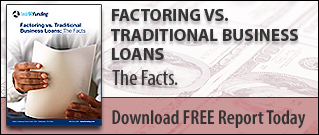 As a business owner, or advisor, it is important to consider various alternatives and oftentimes the most obvious path is the one pursued. Many times when a company is in need of cash flow the immediate thought is to pursue a credit line from a Bank or other financial institution. The first impression is to “get a loan” and use Accounts Receivable as collateral. This may be a possible solution; however, there may be an easier way and that is to “obtain factoring”. Let’s look at the reasons it may be easier and more efficient.
As a business owner, or advisor, it is important to consider various alternatives and oftentimes the most obvious path is the one pursued. Many times when a company is in need of cash flow the immediate thought is to pursue a credit line from a Bank or other financial institution. The first impression is to “get a loan” and use Accounts Receivable as collateral. This may be a possible solution; however, there may be an easier way and that is to “obtain factoring”. Let’s look at the reasons it may be easier and more efficient.
First, one must understand the fundamental difference between lending and factoring. With lending you are obtaining a loan and using the accounts receivable as collateral. With factoring you are selling the accounts receivable to obtain immediate cash. With a loan you create a liability on the balance sheet that effects the leverage and other financial ratios in a potentially negative manner. With factoring you do not create a liability as you are selling the accounts receivable and converting the asset to another asset (cash); therefore, no change in liabilities and no effect to leverage.
Next, the amount of time to access the cash needed should be considered. Typically with a loan one will need to compile a complete financial package including historical financial statements, projections, cash flows, personal financial statements, tax returns and other supporting documentation. With factoring it typically requires a short application that provides the basic information about the company and copies of the invoices/information for the invoices to be factored that has already been prepared and sent to a customer. Where it can take substantial time to accumulate the financial package for a loan the invoices are current in the system and simply need to be forwarded for review.
With a loan the extensive financial package is required as there is a complete review and cash flow analysis performed whereby with factoring the review primarily consists of the invoicing process and the quality of the customer being billed. Along this line, one major misconception with factoring is that the customers need to be “top tier” major accounts. This is not the case as it all depends on the dollar amount of the invoice and the customers demonstrated ability to pay.
When obtaining a loan the lender also looks at the financial strength and personal assets of the business owner as a guarantor and potentially alternative source of repayment. With factoring there is less weight put on the credit strength of the owner, as the focal point again is ultimately the customer. As opposed to a source of financial strength the business owner’s track record of integrity and character is the key.
Given the original purpose of considering a loan was to get access to cash it seems that timing should be an important issue to consider. As a result of the difference in processes to obtain a loan as opposed to factoring, clearly the timeline from start to finish is substantially slower with a loan. Despite what a lender may represent it just takes time to go through all of the steps and can take several weeks or more before getting to loan approval and documentation. Whereas with factoring the typical turnaround to obtain an answer is generally a couple of days with the ability to access the availability of funds within the same business week.
Now let’s take a look at cost. On the surface the cost of a loan may seem significantly less but this may not actually be the case. First, since the loan is financing the cost is determined by an interest rate on the funds borrowed in addition to other fees charged. With factoring there is a “discount rate/fee” that is charged. There is not an interest rate as there is not a loan. The fee is based on a percentage of the total invoice amount from a customer. With the loan the business is incurring a monthly interest expense that will be billed from the lender. With factoring there is no monthly bill to be paid as the fee related to a specific invoice is collected when the customer actually pays the invoice. This alleviates the additional cash flow crunch when trying to cover monthly expenses.
Factoring allows a business to do what they do best and that is provide the quality product or service that they have developed. Simply deliver the product or service, bill and receive cash. So long as there is profit margin in the billed invoice amount to cover the factoring fee then it is a logical, simple, effective and fast way to expedite cash flow.











